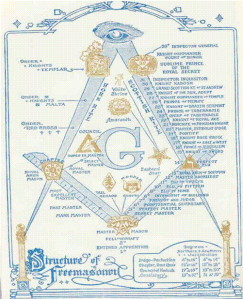Freemasonry 101
January 30, 2010 at 10:07 pm | Posted in Introduction | 1 CommentBefore exploring the key issues in the Christian case against the Masonic Order, it is important to have a basic understand of what Freemasonry is. Many who join the Masonic Lodge become intrigued by its eloquent ritual, its stunning regalia, impressive pageantry, and its universality, including its secret modes of recognition. All of this, of course, will naturally attract interested petitioning candidates, impress the initiates, and “puff-up” its members. Yet rather than instill the virtue of humility, as taught in the Bible, these aspects of the fraternity often build pride and unfortunately encourage an attitude of arrogance, and/or superiority. But, oh how this contrast with Scripture: James 4:6 – “But he gives us more grace. That is why Scripture says: ‘God opposes the proud but gives grace to the humble.’ ”
While a good number of people have, at least, heard about Freemasonry and may even view it as a fraternal or civic organization, most people in the world have no clue as to what it really is. It is our hope that this article and website will help people have a better understanding of this invisible cult within our midst.
What is Freemasonry?
Freemasonry is the world’s largest, oldest and most prominent fraternity. Yet, as you will soon see, it is a cult nonetheless. It started in London in 1717. No one knows for certain how or why it started. It is believed to have originated with the craft guilds of medieval Europe and in recent times, it has expanded to admit those who did not actually belong to an operative trade. Not much is known about the very early, formative years, but not long after its inception, the three foundational degrees were formed.
The Structure of Blue Lodge Masonry
The Blue Lodge consists of 3 degrees, labeled after the trade of Operative Masonry:
- Entered Apprentice (the first degree)
- Fellow Craft (the second degree), and
- Master Mason (the third, considered the most sublime degree in all of Masonry)
Although there are higher degrees within the Order, these 3 degrees represent the foundation of the fraternity and, as such, are the prerequisites to the higher degrees of the York Rite, the Scottish Rite, and the Nobles of the Mystic Shrine, as shown in the following chart:
As noted earlier, that the third degree is the most important degree in Freemasonry. Why is it so important? We answer this question in greater detail in The Masonic Baptism, but for now let’s see what one of Masonry’s authoritative bodies has to say about it:
“It was the single object of all the ancient rites and mysteries practiced in the very bosom of pagan darkness, …to teach the immortality of the soul. This is still the great design of the third degree of Masonry. This is the scope and aim of its ritual. The Master Mason represents man, when youth, manhood, old age, and life itself have passed away as fleeting shadows, yet raised from the grave of iniquity, and quickened into another and better existence. By its legend and all its ritual, it is implied that we have been redeemed from the death of sin and the sepulchre of pollution.”
Source; Ahiman Rezon, page 141, Grand Lodge of South Carolina
On the contrary, the Bible teaches that we are redeemed from the penalty of sin (which is death) by the precious blood of the Lamb of God, Jesus Christ our Lord. What incredible heresy it is for Freemasonry to say that by its legend and all its ritual, it is implied that we (Masons) have been redeemed from the death of sin.
Despite this assertion, many Masons will generally claim that Freemasonry is not a religion, but “A Way of Life.” A basic definition from a Masonic perspective is that it is, “a beautiful system of morality, veiled in allegory and illustrated by symbols.” However, the questions we explore throughout this blog are; is it really just about morality? And, what is the deeper meaning of its allegory and symbols?
To learn more about the Order of Former Freemasons, visit us at www.formermasons.org.
Blog at WordPress.com.
Entries and comments feeds.
